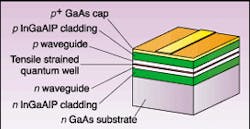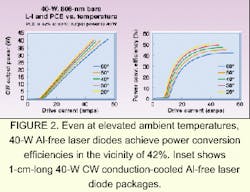DIODE LASERS: New materials promise extended life
MERRILL M. APTER and ARTO SALOKATVE
High-power diode laser bars and stack arrays emitting in the 770- to 840-nm range currently are finding mainstream applications. The devices are commonly used, for example, as pump sources for holmium (Ho), holmium/thulium (Ho/Tm), and neodymium (Nd) based solid-state lasers. Within industrial materials processing, avionics, medicine, and reprographics, diode lasers increasingly are being used. And devices emitting specifically at 770 and 795 nm play key roles in a promising new method for generating polarized noble gases. These lasers, respectively, optically pump potassium and rubidium vapor and produce highly polarized 3He, 21Ne, or 129Xe gases via spin exchange. Researchers currently are studying how these gases might be used in applications ranging from high-resolution medical imaging and physics experiments to mineral exploration.
As demand for high-power laser diode bars and stack arrays has grown, so has demand for higher output powers, brighter sources, and longer lifetimes. But using conventional aluminum gallium arsenide (AlGaAs) laser diodes to achieve these goals has proven to be problematic because of the aluminum in the active junctions of such devices. While aluminum is a key component in these laser diodes—varying the amount of aluminum in the active junction during wafer fabrication changes the peak emission wavelength—it also is highly reactive. Compared to arsenic and gallium, aluminum has a great affinity for oxygen. The resulting oxidation can quickly lead to degraded laser diode performance and eventual device failure.
Two widely documented problems have been specifically tied to the presence of aluminum in a laser diode:
- Catastrophic optical damage—This is the primary early failure mode in high-power, unpassivated AlGaAs devices. Light emission spurs oxidation, leading to increased absorption at the facet. In turn, local temperature builds, cutting the effective bandgap energy, and absorption at the facet increases further. This chain of events eventually results in catastrophic optical damage. Increasing the operating current accelerates the damage process, so an AlGaAs laser diode is, by necessity, limited in its output power.
- Dark-line and dark-spot defects—AlGaAs laser diodes can fall victim to these defects, which consist of nonradiative recombination centers resulting from crystal lattice flaws. Device performance degrades rapidly if these defects form near the active region of a laser, because they extend through the material when the laser is activated. When these defects propagate through an AlGaAs laser diode active junction, they produce localized dark lines or spots that prevent light emission.
Seeking a way of overcoming these limitations, in the late 1980s researchers developed aluminum-free laser diode material—indium gallium arsenide phosphide (InGaAsP)—and found it ideal for fabricating laser diodes with higher output powers, brighter sources, longer lifetimes, and greater reliability than AlGaAs laser diodes. Researchers discovered that, like AlGaAs, the InGaAsP composition could be altered to force changes in lasing wavelength, making InGaAsP devices capable of handling most high-power laser diode applications. In addition, due to the elimination of antioxidation measures in the InGaAsP wafers, overall manufacturing costs for the laser diodes were less than those for AlGaAs devices.
We have been manufacturing aluminum-free active area (AAA) laser diodes in high volume for nearly two years, with a large, field-proven installation base now in place. These devices are used in numerous industrial materials processing, scientific, medical, and graphic arts applications. Creo Products (Burnaby, British Columbia), for example is using 20- and 40-W 830-nm aluminum-free laser diode bars in its thermal prepress imaging systems—more than 1000 of these systems are installed worldwide (see Fig. 1). In addition, in its installed base of 600-plus solid-state, frequency-doubled Nd:YVO4 lasers, Coherent Laser Group uses our aluminum-free 808-nm laser diode arrays as pump sources.Performance advantages
The InGaAsP laser diodes demonstrate impressive performance. Experiments at room temperature show that at the wavelength needed for diode pumping (between 780 and 810 nm), aluminum-free devices function reliably at output powers and brightness levels at least twice as high as those of AlGaAs lasers. Also, at elevated ambient temperatures (typically 35°C to 60°C), InGaAsP devices offer power conversion efficiencies on the order of 42%. In our ongoing room-temperature lifetests of 13 1-cm aluminum-free laser bars emitting 40 W (30% fill factor) at 810 nm continuous wave (CW) the devices have already lasted 6000 hours. Though some commercial diode laser manufacturers have demonstrated output powers of around 40 W from AlGaAs laser diodes, the published lifetime data for these devices are not as impressive as those for aluminum-free laser diodes. We also recently introduced the first commercial 1-cm wide 60-W CW InGaAsP laser bars operating between 790 and 830 nm. Further, our research shows that in the not-too-distant future it should be possible to commercially produce aluminum-free laser diodes that reliably provide 80 to 100 W CW.
Regarding dark-line/dark-spot migration and catastrophic optical damage, InGaAsP laser diode material is clearly superior to AlGaAs. Dark-line and dark-spot migration is not a major problem for InGaAsP devices because the hardening effect of indium stabilizes the crystal matrix. Catastrophic optical mirror damage, as traditionally defined, normally does not occur with InGaAsP laser diodes. Instead, increases in laser current lead to increases in junction temperature, causing carrier leakage from the junction layer. Thermal rollover then occurs—defined as output power peaking at a particular point—with additional increases in current actually reducing output power. Studies show that InGaAsP laser diodes surpass catastrophic optical mirror damage levels of 15 MW/cm2, twice the power-density level of 800 nm-band AlGaAs devices. Working with Jenoptik (Jena, Germany), our engineers have achieved an output of 100 W before thermal rollover occurrence from an 808-nm 1-cm-wide InGaAsP bar (with 19 emitting facets, each 1 mm long and 150 µm wide).1
Other advantages of InGaAsP laser diodes include significantly increased device lifetimes, superior power-conversion efficiency, and lower beam divergence without sacrificing performance. Parameters used to define device lifetime are rate of performance degradation and time needed to lose a certain amount of efficiency. For the current commercial InGaAsP devices, efficiency (at constant output power) drops by less than 1%/1000 hours of operation at ambient temperatures above 35°C. In the area of beam divergence, current InGaAsP devices are characterized by fast-axis divergence of less than 30° (FWHM). For efficient AlGaAs devices, typical fast-axis beam divergence is about 40° (FWHM).
Commercial manufacturing
Given the advantages of InGaAsP laser diodes, then, can these devices be manufactured in the volumes that commercial applications demand? During the past few years we have taken several steps to answer this question. These include ensuring reliable solid-source molecular beam epitaxy (MBE) production of InGaAsP wafers, establishing a world-class, volume production facility, and addressing the carrier confinement issue. Hence, we now offer aluminum-free laser diodes as a mainstream alternative to AlGaAs devices.
Our production facility is fully vertically integrated for the manufacture of InGaAsP laser diodes in volume, with production capabilities in Santa Clara and at Coherent Tutcore Ltd. in Tampere, Finland. Tutcore was established in 1991 as a spin-off from the semiconductor group at Tampere University of Technology and continued the development of Al-free-molecule beam-epitaxy growth technology for optoelectronic devices begun at the University. In particular, Tutcore advanced the state of the art in the fabrication of single-mode Al-free diode lasers. Coherent bought the the majority of Tutcore in 1996 to bring the growth technology and diode laser expertise in-house.
Solid-source MBE growth reactors can grow, at one time, 12 InGaAsP wafers (2-in. diameter). These wafers are of high quality, exhibiting high wafer-to-wafer and batch-to-batch process consistency, and demonstrate high performance at elevated ambient temperatures. And because solid-source MBE is a highly controlled, precise process, capable of producing single-atomic-layer resolution, it allows us to manufacture laser diodes at optimal near-infrared pump wavelengths for the most demanding applications (Ho/Tm:YAG, Nd:YLF, Nd:YAG, Nd:YVO4, rubidium, and potassium vapor pumping).
We noted earlier that poor carrier confinement is a rare downside of InGaAsP laser diodes. When an InGaAsP device incorporates conventional cladding layers, the active junction does not produce a deep quantum well, meaning charge carriers are not held as securely as in AlGaAs devices. As the InGaAsP device's current or operating temperature increases, more and more of the carriers escape. The result is reduced slope efficiency (output power/input current).We addressed this problem by engineering a proprietary device architecture that significantly increases carrier confinement in InGaAsP laser diodes. Aluminum-free devices (at 808 nm) based on this architecture have been operated at 50 W quasi CW at temperatures as high as 75°C and have maintained high (>42%) electrical-to-optical efficiency. This high-temperature capability makes InGaAsP devices suitable for a host of new applications (such as military, industrial, and medical). At the same time, when these devices are built into a system, their high-temperature performance translates into lower demands for thermal management, which reduces overall system costs.
These devices are setting new standards for laser diode performance. Looking ahead, many new applications will be found for high-power laser diodes, and InGaAsP devices will undoubtedly spur a major part of that growth.
REFERENCE
1. F. Daiminger et al., "100 W CW Al-free 808 nm Linear Bar Arrays," Proc. CLEO 1997.
Merrill M. Apter is vice president, sales and marketing, at the Semiconductor Group, Coherent Inc., Santa Clara, CA. Arto Salokatve is manager of growth and epitaxial structures at Coherent Tutcore Ltd., Tampere, Finland; e-mail: [email protected].


